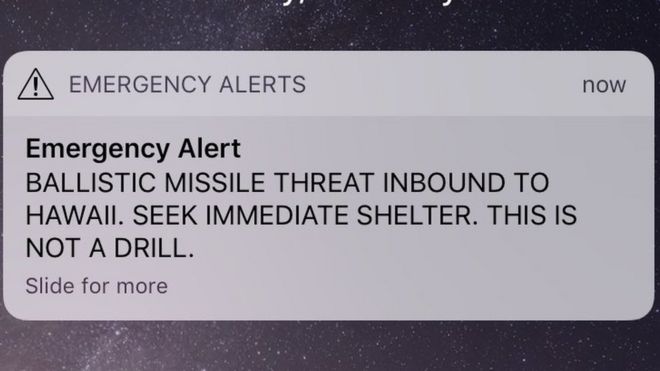
How the message appeared on mobile phones
Thankfully, no such missile attack happened, and I wouldn't be surprised if there are now some pretty hurried investigations going on into how such an embarrassing mistake happened (apparently an official pressed the wrong button during a shift change!). As is common with incidents such as these, the mainstream media have gone overboard in their coverage of the incident, with the word 'panic' yet again being used liberally to describe how people responded (here are some examples are from the BBC and CNBC). However, I would argue, as I have done in the research that I have done on previous mass emergencies (see references below) that people's behaviour during this event were far from the 'panicked' responses that are often assumed, and labeling them as such could have negative long-term consequences.
It's interesting that accounts on social media by people who were in Hawaii at the time tend to be much more nuanced than the mainstream media, and while it is clear that people were fearful and anxious (who wouldn't be in such a situation?), this didn't mean that they were 'panicking' (which implies selfish and/or irrational behaviour). So for example, southpaw tweeted;
The people I was with were pretty stoical. Nervous, but not panicked. The loved ones they were talking with and FaceTiming, though, were often really stressed and terrified
Sydney Ember wrote in the NY Times wrote that while people were clearly fearful & upset, there was also co-operation, and people tried to contact loved ones;
At Konawaena High School on the Island of Hawaii, where a high school wrestling championship was taking place, school officials, more accustomed to alerts of high surf or tsunamis, moved people to the center of the gym as they tried to figure out how to take shelter from a missile.
“Everyone cooperated,” said Kellye Krug, the athletic director at the school. “Once they were gathered, we let them use cellphones to reach loved ones. There were a couple of kids who were emotional, the coaches were right there to console kids. After the retraction was issued, we gave kids time to reach out again.”
It's also worth bearing in mind that in the current context of heightened tensions in the Korean peninsular, and that Hawaii is only 20 minutes away from any missile launch by North Korea, such a text alert could be considered as a credible threat (especially because it wasn't corrected for over half an hour). Therefore, I would say that far from being a 'panicked' response, trying to contact your loved ones and seeking shelter, when you've just had a text alert telling you to do just that, is probably the most sensible and logical thing to do in that situation. Furthermore, in my last blog on a similar incident at Oxford Circus Oxford Circus tube station in London in Nov 2017 (when false rumours of a terrorist attack sparked a mass evacuation), myself and others pointed out that official government advice during emergencies is to Run, Hide, Tell, so it's rather unfair to describe it as 'panic' when people do just that!
I think how this incident unfolded and was reported also illustrates a couple of broader points where there could be serious long-term consequences. Firstly, my issue with the mis-use of the term 'panic' isn't simple word-play, as it implies that people over-reacted, and so in future incidents, people may be less likely to follow advice for fear of social ridicule from others (and/or the media) for 'panicking'. Secondly, the fact that it took over 30 minutes to correct the false text message, means that if a real alert is sent out in future, people could assume that it is another mistake and may delay taking vital precautionary action until it is too late. So, to counter the numerous irrational narratives we have seen about this incident, I would like to finish with a more positive tweet from Jennifer Lazo, an Emergency Manager in the Bay Area, California;
To the people in Hawaii who read the alert and took action- finding shelter, getting kids in a safe spot, telling their neighbors about the alert- Thank you. Don't let anyone tell you that you overreacted. Your response could have saved lives
References:
Cocking C. (2013) Crowd flight during collective disorder- a momentary lapse of reason? Journal of Investigative Psychology & Offender Profiling,10 (2) p.219-36. DOI:10.1002/jip.1389
Drury, J. and Cocking, C. (2007). The mass psychology of disasters and emergency evacuations: A research report and implications for practice. http://www.sussex.ac.uk/affiliates/panic/Disasters%20and%20emergency%20evacuations%20(2007).pdf
Drury, J., Cocking, C., & Reicher, S. (2009a). Every one for themselves? Understanding how crowd solidarity can arise in an emergency: An interview study of disaster survivors. British Journal of Social Psychology 48.
Drury, J., Cocking, C., Reicher, S. (2009b). The nature of collective ‘resilience’: Survivor reactions to the July 7th (2005) London bombings. International Journal of Mass Emergencies and Disasters 27 (1) 66-95.